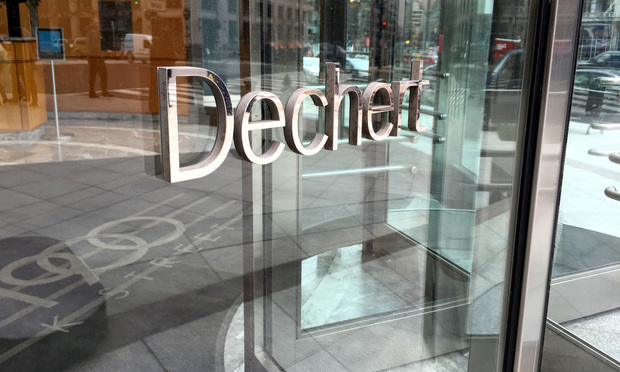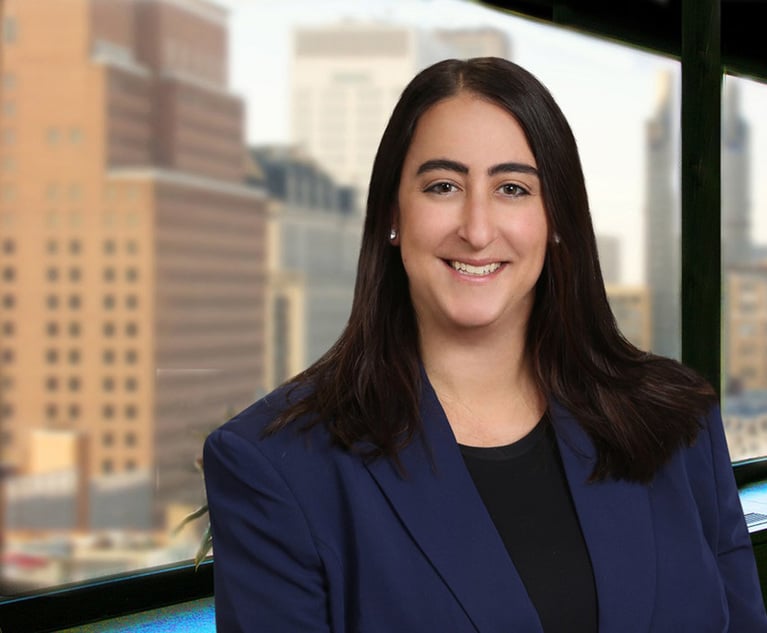Dechert Report Finds Robust Growth in NJ Securities Class Actions
The volume of securities fraud suits against life sciences companies set a nationwide record in 2017, and New Jersey is emerging as a leading venue for such cases, according to a report issued by Dechert.
February 14, 2018 at 04:31 PM
5 minute read
 Photo Credit: Diego M. Radzinschi/ALM
Photo Credit: Diego M. Radzinschi/ALM The volume of securities fraud suits against life sciences companies set a nationwide record in 2017, and New Jersey is emerging as a leading venue for such cases, according to a report issued by Dechert.
Nationwide, plaintiffs filed 88 class action securities lawsuits against life sciences companies in 2017, an increase of more than 30 percent from the 67 suits filed in the previous year, and an increase of more than 225 percent from five years prior.
The growth in suits against life sciences companies mirrors a general uptick in securities class actions—412 suits were filed nationwide in 2017, up from 270 in 2016 and 188 in 2015, said the report, issued Tuesday.
New Jersey saw 13 securities fraud suits against life sciences companies in 2017, up from nine in 2016 and five in 2015.
The overall uptick in securities class actions is attributable to an increase in merger objection suits and to suits driven by events, such as allegations of misconduct by company officials. But life sciences companies face many suits over issues pertaining specifically to their own industry, stemming from alleged misrepresentations about safety or efficacy of a product, negative side effects of products in development, or a product's chances of gaining U.S. Food and Drug Administration approval, the Dechert report said.
One of the report's authors said securities litigation for life sciences and other companies is attributable to a predictable response to a falling stock price by the plaintiff bar.
“I think plaintiffs firms have learned how to craft complaints, and if there's a certain percent stock drop, there will be a complaint filed,” said Joni Jacobsen, a Dechert litigation partner in Chicago.
Noting that a drop in stock price for a life sciences company sometimes follows a regulatory action by the FDA, Jacobsen said, “I do think something about life sciences cases that is attractive to plaintiffs firms.”
But those cases are generally subject to the Private Securities Litigation Reform Act, which makes them subject to a heightened pleading standard, so that many don't survive a motion to dismiss, Jacobsen said.
The Second, Third and Ninth circuits saw the most life sciences shareholder suits in 2017, as in past years, the report said. The Third Circuit was responsible for 23 suits, followed by the Ninth with 19 and the Second Circuit with 17.
In the Third Circuit, New Jersey was the most active state for life sciences securities class actions in 2017, with 13 cases, followed by the Eastern District of Pennsylvania with eight and Delaware with two.
In the Ninth Circuit, the majority of filings, 13 out of 18, came from the Northern District of California. In the Second Circuit, 15 of the 17 suits were filed in the Southern District of New York.
Jacobsen said the growth in volume of New Jersey cases was attributable to the concentration of life sciences companies in the state.
The Dechert report found that more and more shareholder suits against the life sciences industry are aimed at the smallest companies. Roughly half the cases filed were against life science companies with a market cap of $250 million or less, far more than in 2016, and nearly a quarter of the cases filed had a market cap of $50 million or less.
Life sciences suits in 2017 saw mixed outcomes, with 15 cases decided in favor of defendants, 13 cases denying motions to dismiss and seven cases in which only partial dismissals were achieved. Accordingly, in 20 of the 35 decisions in 2017, the plaintiffs' claims were allowed to proceed.
“The numbers illustrate how life sciences companies remain attractive targets for class action securities fraud claims,” said the Dechert report, which offered a series of best practices that companies can implement to reduce their risk of becoming targets.
Three New York law firms account for more than half the shareholder suits against life sciences companies: Levi & Korsinsky, 21 complaints; Pomerantz, 14; and The Rosen Law Firm, 11.
Eduard Korsinsky of Levi & Korsinsky said the uptick in life sciences litigation may be related to the lengthy regulatory process many companies must follow when seeking to bring a new drug to market. Investors who have waited patiently for months or years may be inclined to sue if they hear some bad news about the prognosis for approval of a company's product, he said. In addition, Korsinsky said, the life sciences sector has received more scrutiny lately because of the opioid crisis.
Dechert's best practices include ensuring ”that the sometimes fine line between puffery and statements of fact is not crossed in public statements or filings, or even in extemporaneous statements during conference calls or media commentary.”
This content has been archived. It is available through our partners, LexisNexis® and Bloomberg Law.
To view this content, please continue to their sites.
Not a Lexis Subscriber?
Subscribe Now
Not a Bloomberg Law Subscriber?
Subscribe Now
NOT FOR REPRINT
© 2025 ALM Global, LLC, All Rights Reserved. Request academic re-use from www.copyright.com. All other uses, submit a request to [email protected]. For more information visit Asset & Logo Licensing.
You Might Like
View All

NJ Firm Narrowly Avoids Case Dismissal Over Lengthy Complaint Filed in Fed Court
4 minute read
On the Move and After Hours: Meyner and Landis; Cooper Levenson; Ogletree Deakins; Saiber
3 minute read
AstraZeneca Files Flurry of Lawsuits to Protect Cancer Treatment Drug
3 minute readTrending Stories
Who Got The Work
J. Brugh Lower of Gibbons has entered an appearance for industrial equipment supplier Devco Corporation in a pending trademark infringement lawsuit. The suit, accusing the defendant of selling knock-off Graco products, was filed Dec. 18 in New Jersey District Court by Rivkin Radler on behalf of Graco Inc. and Graco Minnesota. The case, assigned to U.S. District Judge Zahid N. Quraishi, is 3:24-cv-11294, Graco Inc. et al v. Devco Corporation.
Who Got The Work
Rebecca Maller-Stein and Kent A. Yalowitz of Arnold & Porter Kaye Scholer have entered their appearances for Hanaco Venture Capital and its executives, Lior Prosor and David Frankel, in a pending securities lawsuit. The action, filed on Dec. 24 in New York Southern District Court by Zell, Aron & Co. on behalf of Goldeneye Advisors, accuses the defendants of negligently and fraudulently managing the plaintiff's $1 million investment. The case, assigned to U.S. District Judge Vernon S. Broderick, is 1:24-cv-09918, Goldeneye Advisors, LLC v. Hanaco Venture Capital, Ltd. et al.
Who Got The Work
Attorneys from A&O Shearman has stepped in as defense counsel for Toronto-Dominion Bank and other defendants in a pending securities class action. The suit, filed Dec. 11 in New York Southern District Court by Bleichmar Fonti & Auld, accuses the defendants of concealing the bank's 'pervasive' deficiencies in regards to its compliance with the Bank Secrecy Act and the quality of its anti-money laundering controls. The case, assigned to U.S. District Judge Arun Subramanian, is 1:24-cv-09445, Gonzalez v. The Toronto-Dominion Bank et al.
Who Got The Work
Crown Castle International, a Pennsylvania company providing shared communications infrastructure, has turned to Luke D. Wolf of Gordon Rees Scully Mansukhani to fend off a pending breach-of-contract lawsuit. The court action, filed Nov. 25 in Michigan Eastern District Court by Hooper Hathaway PC on behalf of The Town Residences LLC, accuses Crown Castle of failing to transfer approximately $30,000 in utility payments from T-Mobile in breach of a roof-top lease and assignment agreement. The case, assigned to U.S. District Judge Susan K. Declercq, is 2:24-cv-13131, The Town Residences LLC v. T-Mobile US, Inc. et al.
Who Got The Work
Wilfred P. Coronato and Daniel M. Schwartz of McCarter & English have stepped in as defense counsel to Electrolux Home Products Inc. in a pending product liability lawsuit. The court action, filed Nov. 26 in New York Eastern District Court by Poulos Lopiccolo PC and Nagel Rice LLP on behalf of David Stern, alleges that the defendant's refrigerators’ drawers and shelving repeatedly break and fall apart within months after purchase. The case, assigned to U.S. District Judge Joan M. Azrack, is 2:24-cv-08204, Stern v. Electrolux Home Products, Inc.
Featured Firms
Law Offices of Gary Martin Hays & Associates, P.C.
(470) 294-1674
Law Offices of Mark E. Salomone
(857) 444-6468
Smith & Hassler
(713) 739-1250






